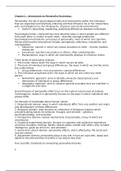Summary
Summary Personality Theory & Assessment - Exam Materials: Complete Book AND Lectures - BSc Psychology Y1, Period 5 - VU University Amsterdam
- Course
- Institution
- Book
Free to download for anyone until the first of September 2021! I hope it helps some who still have to resit in passing the course. Summary of Personality Psychology (2nd ED): all chapters all lecture materials important for the exam. - Contains specific notes from each lecture that were NO...
[Show more]




